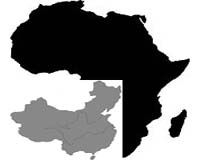 |
New Orleans, Louisiana (AFP) April 26, 2010 Robotic underwater vessels raced Monday to stave off an environmental disaster by stopping 42,000 gallons of oil a day from streaming into the Gulf of Mexico from a sunken rig. A slick measuring 48 miles (77 kilometers) by 39 miles at its widest points has developed 30 miles off the ecologically fragile Louisiana coast since the rig sank last week following an explosion that apparently killed 11 workers. British energy giant BP, which leases the stricken Deepwater Horizon platform, has been using four robotic submarines to try to fully activate the giant 450-tonne blowout preventer and shut off the flow of oil. But BP officials suggest the unprecedented operation, which is being conducted remotely a mile down on the seabed, is a longshot and admit they may have to resort to drilling relief wells, a process that would take far longer. "It is possible that it could take two to three months for a relief well to be drilled," Bill Salvin, a spokesman at the joint information center set up by BP and US-based platform contractor Transocean, told AFP. Salvin also mentioned a "worst-case scenario" that would see recovery teams "lose total control of the well" and cause the oil to start leaking at a much quicker rate. The spokesman told AFP it should be clear by Tuesday morning if the submersible robots have been able to activate the blowout preventer and keep an environmental disaster at bay. "It has not been done before, but we have the world's best experts working to make it happen," said BP executive Doug Suttles. However, Richard Metcalf, a mechanical engineer at the pro-industry Mid-Continent Oil & Gas Association, was not optimistic, telling AFP: "Essentially, they're trying to put a cork in a bottle of champagne." BP has also dispatched 17 skimming vessels to mop up the crude oil spilling from two leaks in the 1,500 foot riser that connected the rig to the wellhead, but those efforts have been hampered by thunderstorms and high seas. The flotilla of skimmers, tugs, barges and other recovery vessels hoped to resume mop-up efforts on Monday, while teams reined in the use of dispersant chemicals due to the sighting of whales near the spill. "The use of dispersants has been adjusted to avoid areas where whales have been spotted. Following adverse weather that went through the area, response crews are anticipated to resume skimming operations today," a statement said. Officials said one of the undersea robots had sent back visual images of sunken tanks containing 700,000 barrels of diesel -- the first report of the "pontoons" that were stacked on the rig before the sinking. "We have no evidence of diesel emanating from the pontoons at this time," said a spokeswoman for the joint information center. Satellite images on Sunday showed the oil slick had spread by 50 percent in a day to cover an area of 600 square miles (1,550 square kilometers), though officials said it was mostly just a thin layer on the gulf's surface. A government expert said the slick would not threaten Louisiana's ecologically fragile wetlands -- a paradise for rare waterfowl and other wildlife -- until Wednesday at the earliest. "In the trajectory analysis we don't see any impact to any shoreline within the next three days," Charlie Henry, scientific coordinator of the National Oceanic and Atmospheric Administration (NOAA), told journalists. While not being anywhere near the same scale yet, the disaster has the potential to be the worst of its kind in the United States since the 1989 Exxon Valdez oil tanker disaster. That spill, considered one of the worst-ever manmade disasters, poured nearly 11 million gallons of crude into Alaska's Prince William Sound, devastating some 750 miles of its once pristine shores. Meanwhile, there was still no news of 11 Deepwater Horizon crew members missing since Tuesday's spectacular blast which shot balls of flame into the night sky. The US coast guard aborted a massive air and sea search for the missing workers on Friday. Investigations are ongoing into the cause of the accident. BP officials have said they believe it was a blowout, caused when pressure control systems fail and oil shoots uncontrolled to the surface.
Share This Article With Planet Earth
Related Links Powering The World in the 21st Century at Energy-Daily.com
 Africa should harness Chinese oil-interest: analyst
Africa should harness Chinese oil-interest: analystCape Town (AFP) March 16, 2010 African states should harness Chinese interest as Beijing's demand for commodities drives growth on the continent and fuels capital investments, an energy conference heard on Tuesday. China's investment model in Africa, characterised by long-term capital concessional financing, was a developmental "no-brainer," Martyn Davies, head of the Frontier Advisory firm, told the Oil and Gas Africa ex ... read more |
|
| The content herein, unless otherwise known to be public domain, are Copyright 1995-2010 - SpaceDaily. AFP and UPI Wire Stories are copyright Agence France-Presse and United Press International. ESA Portal Reports are copyright European Space Agency. All NASA sourced material is public domain. Additional copyrights may apply in whole or part to other bona fide parties. Advertising does not imply endorsement,agreement or approval of any opinions, statements or information provided by SpaceDaily on any Web page published or hosted by SpaceDaily. Privacy Statement |